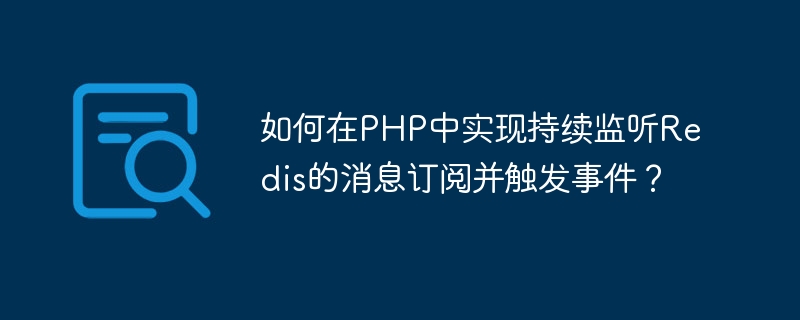Home >Backend Development >PHP Tutorial >How to implement continuous monitoring of Redis message subscription and trigger events in PHP?
How to implement continuous monitoring of Redis message subscription and trigger events in PHP?
- 王林Original
- 2023-09-06 15:14:021244browse

How to continuously monitor Redis message subscription and trigger events in PHP?
Redis is a high-performance key-value database. In addition to conventional key-value storage functions, Redis also supports subscription and publishing systems, allowing multiple clients to communicate through message passing. In PHP, we can use the subscription function of Redis to continuously monitor Redis messages and trigger corresponding events when messages are received.
Before you begin, make sure your server has Redis installed and the PHP Redis extension installed.
First, we need to create a subscriber object to listen to Redis messages. You can use $redis = new Redis() to create a Redis object, and then use the $redis->subscribe() method to subscribe. The following is a simple sample code:
$redis = new Redis();
$redis->pconnect('127.0.0.1', 6379); // 连接Redis服务器
$redis->subscribe(['channel1'], function ($redis, $channel, $message) {
// 接收到消息时触发的事件
echo "Received message from channel: $channel
";
echo "Message: $message
";
});In the above code, we connect to the Redis server and use the subscribe() method to subscribe to the channel named channel1 channel. When a message is received, the code in the anonymous function is called to process the received message.
If there are multiple channels that need to be subscribed, you can pass in an array containing the names of all channels in the parameters of the subscribe() method. For example: ['channel1', 'channel2', 'channel3'].
Of course, in order to keep the program running continuously to monitor Redis messages, we need to use an infinite loop to achieve it:
while (true) {
$redis->subscribe(['channel1'], function ($redis, $channel, $message) {
// 接收到消息时触发的事件
echo "Received message from channel: $channel
";
echo "Message: $message
";
});
}The above code will continue to loop and continue to monitor Redis messages. When a message is received, the source channel of the message and the message content will be output.
In addition to the event processing functions in the above code, we can also process events according to specific needs. For example, the received message can be stored in the database, or other functions can be called for corresponding processing.
In practical applications, we may encounter situations where we need to monitor multiple channels at the same time. To this end, we can use multi-threading so that the subscription and processing of each channel can run independently and process messages from multiple channels in parallel.
The following is a sample code using multi-threading to realize the function of monitoring multiple channels at the same time:
$redis = new Redis();
$redis->pconnect('127.0.0.1', 6379); // 连接Redis服务器
$channels = ['channel1', 'channel2', 'channel3'];
$threads = [];
foreach ($channels as $channel) {
$pid = pcntl_fork();
if ($pid === -1) {
die('Could not fork');
} elseif ($pid) {
// 在父进程中,继续循环创建子进程
$threads[$pid] = $pid;
} else {
// 在子进程中,订阅消息
$redis->subscribe([$channel], function ($redis, $channel, $message) {
// 接收到消息时触发的事件
echo "Received message from channel: $channel
";
echo "Message: $message
";
// 子进程退出
exit();
});
}
}
// 父进程等待所有子进程退出
foreach ($threads as $pid) {
pcntl_waitpid($pid, $status);
}The above code creates multiple sub-codes through the pcntl_fork() function Process, each child process independently subscribes to a channel and triggers corresponding events when receiving messages. The parent process is responsible for waiting for all child processes to exit before ending.
Through the above sample code, you can easily implement the function of continuously monitoring Redis message subscriptions and triggering corresponding events in PHP. Whether monitoring a single channel or multiple channels, it can be flexibly adjusted and expanded as needed.
The above is the detailed content of How to implement continuous monitoring of Redis message subscription and trigger events in PHP?. For more information, please follow other related articles on the PHP Chinese website!
Related articles
See more- Summary of the latest PHP interview questions in 2023 (with answers)
- Linux checks whether redis is started
- How to uninstall Redis in Linux?
- How to implement continuous listening to Redis message subscription and handle delayed tasks in PHP?
- How does PHP continuously listen to Redis message subscriptions and process them?

